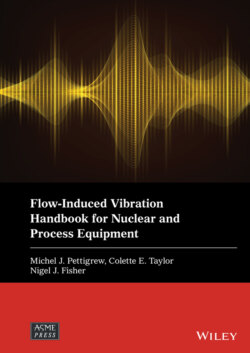Читать книгу Flow-Induced Vibration Handbook for Nuclear and Process Equipment - Группа авторов - Страница 39
2.4.2 Random Turbulence Excitation
ОглавлениеRandom turbulence excitation is a significant excitation mechanism in both liquid and two‐phase cross flow. Formulations for single‐ and two‐phase cross flow are given below. The topics are discussed in more detail in Chapters 9 and 10 for single‐ and two‐phase flow, respectively.
To be able to compare data and find an upper bound, the excitation forces must be presented as a normalized excitation force spectra. Researchers in this field such as Taylor and Pettigrew (1998), and Pettigrew and Gorman (1981) have used various methods of normalizing their results. Therefore, it was necessary to select one means of normalization and apply it to all of the data. The adopted method is the “equivalent power spectral density (EPSD),” first described by Axisa et al (1990).
Fig. 2-13 Effect of P/D on Fluidelastic Instability Constant in Two‐Phase Cross Flow.
The power spectral density (PSD), , can be rendered dimensionless using a pressure scaling factor, po, and a frequency scaling factor, fo, as follows:
(2‐27)
where, fR is the reduced frequency, defined as f/fo, and D is the tube diameter.
A difficulty arises in the calculation of SF(f) because the correlation length, λc, is rarely known. Axisa et al (1990) present a dimensionless EPSD, , defined as follows:
(2‐28)
where, Le is the excited tube length. Using this definition, the dimensionless EPSD for Mode 1 can be defined in terms of the mean square of tube displacement, as follows:
(2‐29)
where, ϕ1(x1) is the normalized mode shape for the 1st mode, a1 is the numerical coefficient for the 1st mode, f1 is the 1st mode tube natural frequency, m is the total tube mass (tube mass + hydrodynamic mass) and ζ1 is the damping ratio for the 1st mode. Values of and a1 are 2.0 and 1.1, respectively, for pinned‐pinned end conditions.
Using Eq. (2-29), the mean square of tube displacement can be found without knowledge of the correlation length. Instead, a small correlation length is assumed. To correctly compare spectra obtained using experimental rigs with varying geometries, it is necessary to define a dimensionless reference EPSD, , based on a reference excited tube length, Lo, and a reference tube diameter, Do, as follows:
(2‐30)
where, Le, is the excited tube length. In this chapter, reference lengths of Lo = 1 m and Do = 0.02 m are applied.
